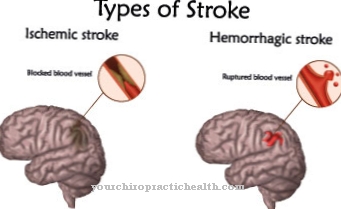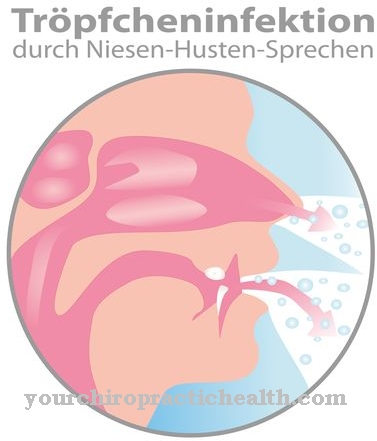A septic shock is a so-called inflammatory reaction of the organism. The body reacts to the invasion of viruses, bacteria, fungi and toxins with multi-organ failure. If adequate and timely treatment is not given, septic shock is usually fatal. A septic shock must be differentiated from anaphylactic shock (allergic shock) and circulatory shock.
What is Septic Shock?

A septic shock is when symptoms of SIRS (systemic inflammatory response syndrome) occur. Furthermore, there must be an infectious cause (bacteria, viruses, fungi or toxins) as well as a systolic blood pressure of less than 90 mmHg.
The low blood pressure (hypotension) must persist for at least one hour despite volume substitution. In addition to a fever and an accelerated heartbeat, the breathing rate is increased and there are disturbances in the blood count.
The septic shock is based on sepsis (blood poisoning). If an organ or multiple organ failure occurs, combined with a drop in blood pressure, this is defined as septic shock.
Septic shock can be divided into three stages:
Stage 1: The beginning septic shock - is characterized by: body temperature above 38.4 ° C, stable tachycardia (accelerated heartbeat), hyperventilation, platelet count in the blood is within the normal range, intensive monitoring required.
Stage 2: Septic shock: Reduction of the platelet count, hyperdynamic or hypodynamic shock, evidence of bacteremia and endotoxemia, ventilation of the affected person urgently required.
Stage 3a: Remission: significant improvement.
Or stage 3b: Therapy-refractory condition: no improvement in symptoms, condition of the patient cannot be influenced even by aggressive therapy, so that the septic shock ultimately leads to death.
causes
A septic shock is caused by bacteria, viruses, fungi, or toxins that have entered the bloodstream. The introduction of bacteria is often caused by medical measures such as B. punctures, operations, catheter infections or by taking certain drugs.
Septic shock is usually the result of sepsis (blood poisoning). But other diseases such as B. Cancer, end-stage kidney disease, Lemierre's syndrome, gangrene, peritonitis, as well as inflammation of the lungs, pancreas and gallbladder, can be a cause of septic shock.
Sepsis and subsequent septic shock can also result from burns to the skin or other open wounds.
Symptoms, ailments & signs
Septic shock can cause a number of symptoms and ailments. Initially, the shock reaction leads to cardiovascular problems: palpitations, high blood pressure and fluctuations in blood pressure. At the same time, blue lines or redness appear under the skin. The skin changes occur predominantly on the extremities and enlarge rapidly.
The accompanying blood poisoning initially causes a severe fever and malaise and, as the disease progresses, leads to serious circulatory problems. Chills and confusion are also occasional. The fever can also lead to hypothermia, in which the body temperature drops below 36 degrees Celsius.
The clearest sign is the red line that develops towards the heart. The red line can be slightly sensitive to pressure and is clearly visible on the outside. If it reaches the heart, heart failure threatens. If the course is severe, sepsis can be fatal.
Early treatment prevents serious complications and leads to a rapid recovery in 80 percent of patients without further symptoms or discomfort. Occasionally there may be a protracted fever and physical weakness. These signs of illness subside completely within a few weeks.
Diagnosis & course
Is diagnosed a septic shock through a blood test. This searches for the pathogen that triggered the inflammatory chain reaction.
Furthermore, a septic shock can be recognized on the basis of the course of the disease during sepsis. The first signs are red or blue lines on the arms and legs, swollen lymph nodes, high fever, tachycardia, hyperventilation, impaired consciousness, hypotension and organ failure.
Sepsis is usually associated with circulatory disorders, a drop in blood pressure and organ failure. If sepsis is not treated adequately and in good time, septic shock will result. If no effective countermeasures are taken or if the therapy does not work, septic shock is usually fatal. The mortality rate from sepsis or septic shock is around 50 - 60 percent.
Complications
In septic shock, the circulatory system collapses due to a drop in blood pressure, which is due to, mostly bacterial, poisoning. A septic shock is therefore always extremely life-threatening. The low blood pressure and small blood clots can lead to a number of serious complications.
The blood supply to vital organs such as the brain, heart, lungs or kidneys can be impaired. When the body tissue does not receive enough blood, it releases excess lactic acid, which threatens metabolic acidosis. Furthermore, thrombocytopenia can set in because the platelet survival time decreases due to the progressive poisoning processes. In addition, a shock kidney, i.e. acute kidney failure, is to be expected if the urine volume decreases too much.
If the lungs are affected, symptoms such as hyperventilation due to a lack of oxygen and shortness of breath can occur. In these cases, there is a risk of shock lung, i.e. acute lung failure. Insufficient blood flow to the gastric mucosa in connection with an increased formation of gastric juice can lead to a stress ulcer, i.e. damage to the gastric mucosa caused by stress. If the sepsis cannot be contained, the worst complication is acute multiple organ failure, which regularly leads to death.
When should you go to the doctor?
A doctor must always be consulted with this disease. Self-healing cannot occur, so the affected patient is dependent on medical treatment. In the worst case, the affected person dies from this shock if the disease is not treated. A doctor should be consulted if the person concerned suffers from palpitations and high blood pressure.
There is also severe reddening of the face and most patients also have a fever. If these symptoms occur, a doctor must be consulted in any case. It is not uncommon for those affected to appear confused or suffer from chills and a general feeling of illness. If this shock is left untreated, heart failure usually occurs.
In the event of such a shock, an emergency doctor should be called directly or the hospital should be visited. Further treatment is then carried out in the hospital, which usually requires a further stay.
Treatment & Therapy
A septic shock is a medical emergency and requires immediate medical treatment. Depending on which pathogen was determined to be the cause of the septic shock, drug therapy with antibiotics, antivirals, antimycotics or antiparasitics is initiated.
Furthermore, there is a volume substitution. In addition to avoiding desiccosis (dehydration), the infusion fluid serves to balance the water and electrolyte balance. Since a septic shock is associated with multiple organ failure, drug measures are also taken to stabilize the affected organs.
Septic shock can also affect blood clotting, so steps must be taken to avoid thrombosis or embolism.
The drop in blood pressure leads to a circulatory disorder in the extremities and organs. Due to the reduced circulation of the blood, a lack of oxygen occurs as a result, which can lead to impaired consciousness and coma. The circulatory disorder, together with the blood clotting disorder, can result in thrombosis, so that in addition to the administration of oxygen and blood-thinning agents, more fluids have to be administered.
Sepsis or septic shock are often triggered by an infected wound. Because of this, it is necessary that the focus of infection be surgically removed.
Since breathing is often restricted, i. d. Usually an intubation performed. In addition to these measures, general, circulation-preserving measures are also carried out in the event of a septic shock.
prevention
One septic shock can be prevented by ensuring a sterile environment during operations in hospitals and medical practices. Thorough wound disinfection must be carried out after the operation. The daily dressing changes must also be carried out under sterile conditions.
But not only operations in the hospital can trigger septic shock. Every wound, no matter how small or insignificant, should be adequately disinfected immediately. There are disinfectants for skin and wounds that belong in every medicine cabinet in the home and at work.
Some people suffer from poor wound healing. This group should always consult a doctor - even with small wounds - to have the wound professionally cared for so that sepsis and septic shock can be avoided.
Aftercare
Anyone who has ever suffered septic shock may be scarred for life. But the body was strong enough to fight its way through this severe infection, even if it was damaged. The task now is to compensate for this damage in the long term. In general, this is best achieved through a healthy lifestyle. First of all, this includes nutrition.
It should be light and digestible, rich in vitamins and low in fat. If the kidneys were affected by septic shock, a low-potassium diet is also recommended. The patient should only resort to fast food in an emergency. Instead, we recommend freshly prepared dishes with lots of vegetables and salad. Pleasure poisons such as nicotine and alcohol place unnecessary stress on both the liver and the entire organism.
Regulated rest periods and sufficient sleep give the body the opportunity to carry out repair measures without stress. Exercise, which is best done in the fresh air, improves blood circulation and oxygen uptake. The patient may suffer psychologically after the life-threatening shock situation.
Knowing that you nearly died can be very stressful. Psychotherapeutic crisis intervention is advisable here. Of course, the patient should also avoid injuries in the future. If he has sustained a wound, it is important to watch out for its healing process.
You can do that yourself
Many things often change in life for patients who have suffered septic shock. Depending on the severity of the disease, the main thing is a good healing process. Participation in self-help groups shows those affected how they can regain their quality of life. Above all, the immune system needs to be strengthened in order to arm itself against new pathogens.There are also other useful auxiliary measures to reduce the risk of a physical shock reaction.
Anyone suffering from diabetes mellitus should stick to the prescribed diet. People with implants, catheters or stents are also at risk and should take good care of themselves. In the case of inflammation, the risk increases sharply, and immune deficiencies can promote septic shock. It is intrinsically important for those affected to observe their bodies and to notice any problems early on. Regular visits to the doctor are just as much a part of everyday life for those at risk as a healthy lifestyle.
By attending a self-help group or receiving comprehensive psychotherapeutic care, those affected learn more about this disease and how best to deal with the constant danger.


.jpg)





















.jpg)



